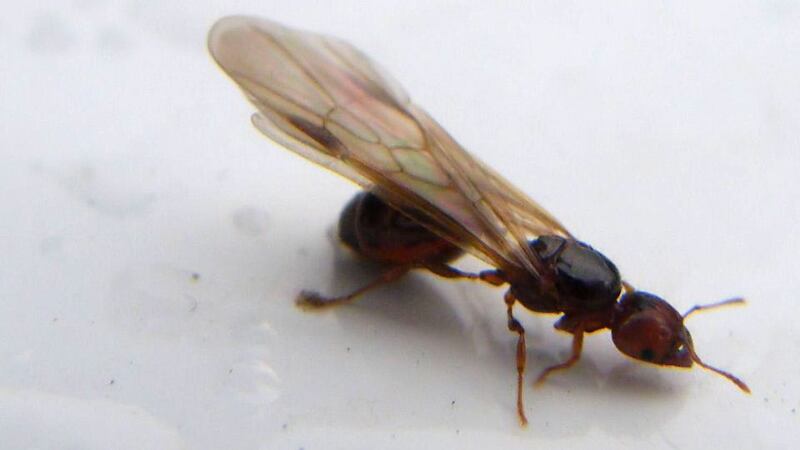The great spell of warm weather appears to be bringing all sorts of calamities with it: jellyfish, hay fever, flying ants, sudden fog and aggressive seagulls. Are these freaks of nature or just normal summer occurrences? We asked some experts.
Why is it suddenly foggy when the weather is so good?

“What we saw on Dublin beaches recently is sea fog, which is very different to the type of fog you get inland,” says John Eagleton, a forecaster at Met Eireann. “To understand where it comes from you have to understand a measure called dewpoint. Dewpoint is a water-to-air saturation point and related to humidity. In simple layman’s terms, to get the dewpoint you measure the dry air temperature and then measure it again with wet cotton wool on the thermometer. The temperature will drop. This lower reading is the dewpoint. At sea, when the dewpoint and the core water surface temperature are close or the same you have the ideal conditions for fog. On hot days, as sea water evaporates it turns into fog. The quicker the evaporation, the thicker the fog. If it’s not windy the fog hangs in the air. So this is why a hot, humid, calm day on the beach can turn suddenly foggy. Sea fog loves heat, humidity and windless days.”
Why the explosion in aggressive seagulls?

“Forget the idea of an explosion,” says Steven Newton, senior seabird conservation officer at Birdwatch Ireland. “There’s been a gradual growth over ten years in specific nesting spots from Dún Laoghaire to Howth and in towns like Rush, Skerries and Donabate - but no explosion. In 2001 there were 100 pairs recorded around Dublin. Now it’s estimated that many hundreds of pairs have established themselves in urban areas but it’s been a steady increase. If they’re swooping down on you they’re stealing rather than attacking and they’ve learned that behaviour from humans feeding them, particularly when they’re young. You can put chicken wire around your chimney pots to deter them but not much else. They’re a protected sea bird. If they’re nesting on your roof you can expect a long stay,” he says. “They live for about 10-20 years.”
Is there really a surge in hay fever?

"There definitely is a surge in hay fever incidences in Ireland this year," says Dr Paul Carson of Allergy Ireland. "It's due to a perfect storm of very wet weather in early June followed by a prolonged period of warm weather during the peak of the hay fever season: May to the end of June. Consequently, there's been a dramatic increase in grass pollen. Sufferers who in a normal summer had minor symptoms and passed them off as a head cold, are experiencing much stronger symptoms this year. They go to their GP and are being diagnosed with hay fever – they probably always had it but with a high tolerance level. The symptoms can be very debilitating: in the worst case you can have a totally obstructed nose, itchy eyes, patches of eczema and wheezing. An often missed symptom is feeling totally drained, exhausted even. Often people go to bed to recover and self-medicate but it's very treatable. If you suspect you have hay fever go to your GP. There are some fantastic new prescription medicines available. They can give you back the quality of life everyone else is enjoying in this fine weather. You deserve to enjoy it too." For more detailed information on hayfever see allergy-ireland.ie
Where are all the flying ants coming from?

If you missed flying ants day in your area you’ll probably have to wait a while before it happens again. Recently, many people reported battling through swarms of flying ants in the early evening. Birds noticed them too, so flocks of excited gulls and sparrows were also reported, busy in the hunt for food. What was happening is called a nuptial flight: young queen and male ants emerge from a colony to mate and begin new colonies – sometimes in their thousands. They do this when the weather conditions, humidity and wind speed are right and so they appear to swarm as if on cue, and once one is out all the other ants get very excited. Emerging together is a benefit though as they’re able to mix and mate across different colonies – although the male of the species reportedly don’t make it past the mating stage.
Are we due an army of jellyfish next?

“There’s been no real big increase in jellyfish numbers,” says Dr Tom Doyle, a research fellow in University College Cork. “We have 30 jellyfish species in Ireland. The only one that has bloomed in really big numbers is the Barrel jellyfish. They can weigh up to 30kg and are normally found washed up in a quite limited number of places. This year they are all over the country – Wexford, Wicklow, Clare, Cork. They have no tentacles but do have what looks like a huge cauliflower hanging below the bell of the jellyfish. This is actually thousands of mouths searching for food. They have a very mild sting. At the other end of the scale we have the Lion’s Mane jellyfish. This is particularly common around Dublin and has up to 1,000 tentacles and a very serious sting. It can cause abdominal pain and back pain. If you swim into a bloom of these you need the doctor fast. Urine or other home remedies won’t help.
"Not many people know that jellyfish as we know them are only part of the life cycle. They can live for 10-20 years as polyps attached to the seabed which then go on to give rise to jelly fish. The jelly fish that we see washed up on the beach only live for a few months. There is no particular jellyfish season. They are in the sea all year round but we only tend to notice them when we're on the beach ourselves." For more see jellyfish.ie











